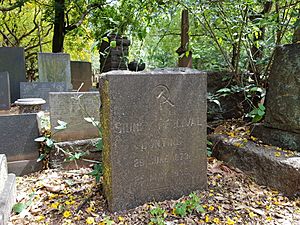Sidney Bunting facts for kids
Sidney Percival Bunting (born June 29, 1873 – died May 25, 1936) was a politician from South Africa, originally from Britain. He helped start the Communist Party of South Africa (CPSA).
Early Life
Sidney Bunting was born in London, UK, on June 29, 1873. His father, Sir Percy William Bunting, was an editor for a British magazine called 'The Contemporary Review'. This magazine focused on social improvements.
His mother, Mary Hyett Bunting, was a social worker. She worked to help people in poor areas of London. She also welcomed people from many countries into her home. Sidney had one brother and two sisters.
Two mission stations in what is now South Africa were named after his great-grandfather, Jabez Bunting. He was a Methodist minister.
Sidney went to St Paul's School in London. After that, he studied Classics at Magdalen College, Oxford University. He won a special prize there in 1897. After university, he trained to become a lawyer.
Moving to Johannesburg
In 1900, Sidney joined the British army as a volunteer. He fought in the Second Boer War. After the war, he decided to stay in Johannesburg, South Africa.
He studied on his own and earned a law degree in 1904. This allowed him to work as a lawyer. Sidney also loved music. He played string instruments, helped organize concerts, and wrote reviews about music.
In 1916, he married Rebecca Notlewitz. She was of Jewish background and had moved from Lithuania.
Political Journey
Sidney Bunting was an early supporter of the South African Labour Party (SALP). This party formed after workers went on strike starting in 1907. It was mostly made up of middle-class people of European background.
In 1914, Bunting was elected to represent Bezuidenhout Valley in the Transvaal province. The Labour Party won a small majority in that election.
The SALP worked closely with trade unions. However, it often supported special rights for white workers. This was especially true in gold mining and related industries.
In September 1914, Bunting led some party members who did not want South Africa to join World War I. Because of this, he and others were removed from the party. He then helped create the International Socialist League (ISL).
Bunting supported the Russian October Revolution. The ISL later became the Communist Party of South Africa (CPSA).
In 1921, Sidney and Rebecca Bunting were among the first members of the CPSA. In 1922, they both went to a big meeting in Moscow, Soviet Union. This meeting was for the Communist International (Comintern).
When they returned, Sidney Bunting became the secretary of the CPSA. In 1924, he became its chairman.
As chairman, he tried to encourage Black opposition leaders to join the revolution. The party gained many Black members. Bunting often defended them in court without asking for money.
In 1928, he went back to the Soviet Union. He disagreed with the Comintern's idea that the CPSA should support a "Native Republic." But the Comintern insisted on this plan.
In the 1929 election, Bunting ran as the CPSA candidate for Thembuland. Even though many Black people could vote there, he only received 289 votes.
Later Years
In 1931, Sidney Bunting was removed from the party. This happened because of political disagreements. He lost his job as a lawyer and faced financial difficulties. He then became a viola player in an orchestra that toured with cinemas.
After having a stroke, his fingers became paralyzed. He then worked as a caretaker. Sidney Bunting died on May 25, 1936, after a second stroke.
His ashes are buried at Braamfontein Cemetery in Johannesburg.
Sidney and Rebecca Bunting had two children:
- Arthur Bunting, who became a botanist at the University of Reading.
- Brian Bunting, who became an important member of the South African Communist Party (SACP). He also edited many newspapers that spoke out against the government.
Writings
- S.P. Bunting: Res Nautica apud Antiquos: Oratio Latina, Chancellor's Latin Essay. B.H. Blackwell, Oxford 1897
- Brian Bunting (ed.): Letters to Rebecca: South African communist leader S.P. Bunting to his wife, 1917-1934. Mayibuye history and literature series, episode 67, Mayibuye Books, UWC, Bellville 1996, ISBN: 978-1868082995.
More Information
- Allison Drew: Between Empire and Revolution: A Life of Sidney Bunting (PDF 3.55MB). Routledge, London, New York 2007, ISBN: 978-1851968930.
- Edward Rudolph Roux: S.P. Bunting. A political biography (PDF 627KB). Cape Town 1944.


